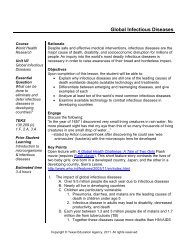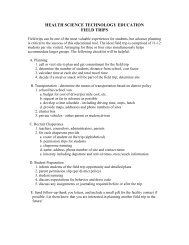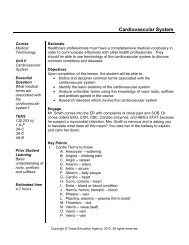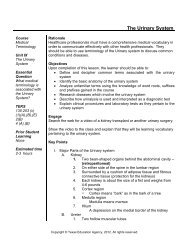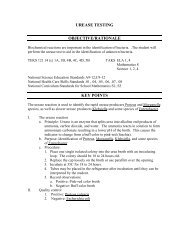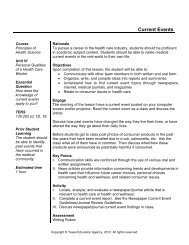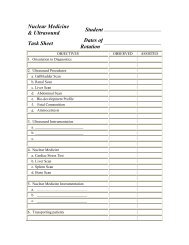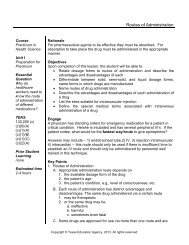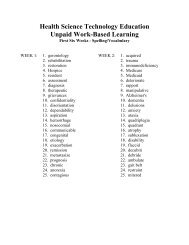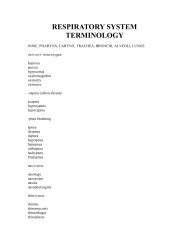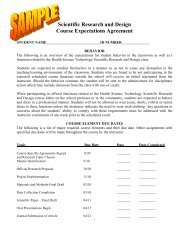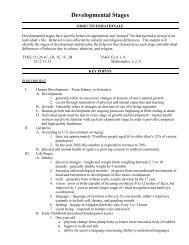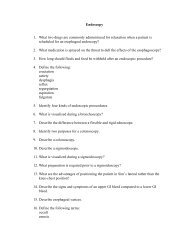Then and Now: Disease and Technology Through the Ages
Then and Now: Disease and Technology Through the Ages
Then and Now: Disease and Technology Through the Ages
Create successful ePaper yourself
Turn your PDF publications into a flip-book with our unique Google optimized e-Paper software.
Course<br />
World Health<br />
Research<br />
Unit I<br />
<strong>Then</strong> & <strong>Now</strong>:<br />
<strong>Disease</strong> &<br />
<strong>Technology</strong><br />
<strong>Through</strong> <strong>the</strong><br />
<strong>Ages</strong><br />
Essential<br />
Question<br />
How does<br />
chronology lead<br />
to underst<strong>and</strong>ing<br />
of historical<br />
relationships<br />
between disease<br />
<strong>and</strong> technology?<br />
TEKS<br />
130.209(c) 1B<br />
Prior Student<br />
Learning<br />
World History<br />
Estimated time<br />
Lecture/PPT I:<br />
45 min.<br />
Lecture/PPT II:<br />
45 min.<br />
<strong>Then</strong> <strong>and</strong> <strong>Now</strong>: <strong>Disease</strong> <strong>and</strong> <strong>Technology</strong> <strong>Through</strong> <strong>the</strong> <strong>Ages</strong><br />
Rationale<br />
<strong>Disease</strong> drives technology <strong>and</strong> both continue to evolve <strong>and</strong> change societies<br />
since prehistoric times.<br />
Objectives<br />
Upon completion of this lesson, <strong>the</strong> student will be able to:<br />
• Identify <strong>the</strong>rapeutic techniques used by primitive people<br />
• List <strong>and</strong> discuss ancient herbs used for healing<br />
• Compare medical practices during <strong>the</strong> Dark <strong>Ages</strong> to that of primitive<br />
people<br />
• Identify major medical discoveries, inventions, <strong>and</strong> scientific<br />
achievements, of <strong>the</strong> 17 th – 20 th centuries <strong>and</strong> assess <strong>the</strong>ir impact on<br />
societies<br />
• Discuss biomedical breakthroughs of <strong>the</strong> late 20 th <strong>and</strong> 21 st centuries<br />
Engage<br />
Many of you are here today because penicillin saved your life, or <strong>the</strong> life of<br />
one of your parents or gr<strong>and</strong>parents. Penicillin's ability to cure people of<br />
many once-fatal bacterial infections has saved so many lives that it is easy<br />
to underst<strong>and</strong> why it was once called a "miracle drug".<br />
http://herbarium.usu.edu/fungi/funfacts/penicillin.htm<br />
Note: In lieu of <strong>the</strong> <strong>Then</strong> <strong>and</strong> <strong>Now</strong> lesson plans <strong>and</strong> instructional multimedia<br />
presentations below, <strong>the</strong> students can view PBS A Science Odyssey –<br />
Matters of Life <strong>and</strong> Death<br />
Key Points<br />
PART I (Instructional Multimedia Presentation #1 accompanies this lesson)<br />
A. Prehistoric animals<br />
1. Long before humans were on earth, <strong>the</strong>re was disease.<br />
a. arthritis – seen at joints of prehistoric animal bones<br />
i. since animals often retreated to caves to die, this is where<br />
many bony remains were found<br />
ii. lipping (bony overgrowth) seen in joints of excavated bones.<br />
iii. Arthritic bones were so common in dinosaurs <strong>and</strong> prehistoric<br />
bears that archeologists began to refer to it as “cave gout”.<br />
b. Skeletal fractures - some healed with little deformity, o<strong>the</strong>rs show<br />
effects of infection (osteomyelitis)<br />
Copyright © Texas Education Agency, 2012. All rights reserved.
c. Extensive calluses (bone "scars" associated with healing<br />
fractures)<br />
B. Ne<strong>and</strong>erthal man<br />
1. bone reconstruction revealed a stooped, round-shouldered skeleton<br />
with a curved spine <strong>and</strong> bent knees<br />
2. early speculation by anthropologists was that this was a gorilla-type<br />
man—<strong>the</strong> missing link<br />
3. scientists now think Ne<strong>and</strong>erthal man was suffering from disfiguring<br />
arthritis<br />
C. Primitive people<br />
1. nomads who were hunters <strong>and</strong> ga<strong>the</strong>rers<br />
2. believed illness was caused by invasion of evil spirits <strong>and</strong><br />
supernatural forces<br />
3. diseases/conditions that prehistoric man suffered from:<br />
a. tuberculosis <strong>and</strong> parasitic infections<br />
b. under calcified bones (osteoporosis)<br />
c. caries (decayed teeth)<br />
d. pyorrhea (eroded teeth from discharge of pus from inflamed gums)<br />
e. skeletal fractures<br />
4. health issues for prehistoric women:<br />
1. had much shorter lifespan than men due to difficult childbirth<br />
2. weakened immune systems<br />
a. birthing <strong>and</strong> nursing children<br />
b. malnourishment since best food was for men <strong>and</strong> boys<br />
because <strong>the</strong>y were/would be leaders, hunters, <strong>and</strong> warriors<br />
5. <strong>the</strong>rapeutic techniques used by primitive healers/shaman<br />
1. praying<br />
2. chanting<br />
3. hallucinogenic trances – a means of communication with <strong>the</strong> spirit<br />
world<br />
a. typically <strong>the</strong> shaman will go into a trance with help of<br />
hallucinogenic plants<br />
6. Therapeutic tools of primitive people<br />
1. facial <strong>and</strong> body paints to scare away evil spirits<br />
2. wood splints to stabilize <strong>and</strong> protect injuries<br />
3. casts from hardened hide for bone fractures<br />
4. bone needles threaded with strip of animal tendon to sew<br />
lacerations<br />
7. Prehistoric medicinal herbs<br />
1. foxglove plant<br />
a. treatment for failing heart<br />
b. streng<strong>the</strong>ns <strong>and</strong> slows heart (more efficient ejection)<br />
c. drug from foxglove plant is digitalis<br />
2. birch fungus<br />
Copyright © Texas Education Agency, 2012. All rights reserved.
a. treatment that stops bleeding <strong>and</strong> acts as a disinfectant<br />
b. can be used as a laxative when ingested<br />
3. peek-a-boo plant (“toothache plant”)<br />
a. treatment of toothaches <strong>and</strong> oral infections<br />
b. chewed leaves or flower head, numbs tongue <strong>and</strong> mouth<br />
4. bark of cinchona tree<br />
a. treatment for malaria<br />
b. used to help relieve malaria’s fever <strong>and</strong> muscle spasms<br />
c. drug from cinchona bark is quinine<br />
5. opium poppy<br />
a. treatment for relief of severe pain<br />
b. allowed ancient surgeons to perform prolonged surgical<br />
procedures<br />
c. highly addictive<br />
d. drug from opium poppy is morphine<br />
6. belladonna plant (also known as “deadly nightshade plant”)<br />
a. treatment for spastic colon <strong>and</strong> gastric ulcers<br />
b. also used for bradycardia<br />
c. ancient women used it to dilate eyes because <strong>the</strong>y thought it<br />
made <strong>the</strong>m look beautiful<br />
d. drug from belladonna plant is atropine<br />
8. Examples of “good medicine” during primitive times<br />
1. frightening or cajoling evil spirits out of its victim <strong>the</strong>n casting <strong>the</strong><br />
offending spirit to a vermin or insect <strong>and</strong> stomping on it<br />
2. trepanation (drilling hole in head) was used to treat headaches<br />
<strong>and</strong> odd behavior; it was thought to release evil spirits<br />
3. sucking <strong>and</strong> vomiting<br />
a. healer blew tobacco smoke over patient <strong>the</strong>n gulped in large<br />
amounts of smoke until he/she became nauseated<br />
b. once nauseated, healer would begin sucking on patient’s chest<br />
(to remove evil spirit)<br />
c. healer would <strong>the</strong>n vomit to purge <strong>the</strong> evil, <strong>the</strong>n buy <strong>the</strong> vomit<br />
9. Besides healing, healers <strong>and</strong> shamans were also responsible for<br />
warding off all potential catastrophes such as:<br />
1. bad wea<strong>the</strong>r<br />
2. unyielding crops<br />
3. unsuccessful hunts<br />
4. enemy warriors<br />
D. Earliest ancient civilizations – did not move around like prehistoric<br />
people; built societies<br />
1. The Egyptians (3150 BC)<br />
a. first to keep accurate written health records<br />
b. medical practice included bloodletting, monthly purging, making<br />
pros<strong>the</strong>tic devices, embalming<br />
c. surgeons in ancient Egypt were both priests <strong>and</strong> doctors who<br />
Copyright © Texas Education Agency, 2012. All rights reserved.
lended ritual with medicine<br />
2. Ancient India (3300 BC)<br />
a. detected diabetes by smelling <strong>and</strong> tasting urine for sweetness<br />
b. practiced surgical procedures such as hernia repairs, amputations,<br />
C-sections, cosmetic surgery to nose, earlobes <strong>and</strong> harelips<br />
3. Ancient China (15 Century BC)<br />
a. illness was still seen as a violation of a god<br />
b. male doctors didn’t directly examine women<br />
c. ivory dolls were used by doctors to diagnose woman (<strong>the</strong>y would<br />
point to <strong>the</strong> area of discomfort or pain)<br />
d. also used acupuncture to treat ailments (believed that <strong>the</strong> needles<br />
stimulated energy points throughout <strong>the</strong> body, relieving<br />
obstructions, enabling <strong>the</strong> body to heal)<br />
e. used a variety of herbs to treat diseases, which were thought to<br />
throw away <strong>the</strong> evil intruders of <strong>the</strong> body<br />
i. ginseng – reduces stress<br />
ii. rhubarb – enhances body strength<br />
iii. licorice – relieves muscle spasms<br />
iv. ginger – treats diarrhea<br />
v. peony – regulates blood<br />
vi. salvia – relieves pain of inflammation<br />
PART II (Instructional Multimedia Presentation #2 accompanies this lesson)<br />
E. Ancient secondary societies<br />
1. Ancient Greece<br />
a. <strong>the</strong> first to study <strong>the</strong> cause of disease<br />
i. looked for natural explanations, not just divine ones<br />
ii. made discoveries in science, math, <strong>and</strong> astronomy<br />
b. Hippocrates was one of <strong>the</strong> most famous of <strong>the</strong> ancient Greek<br />
physicians<br />
i. based his knowledge of anatomy on observation of <strong>the</strong> external<br />
body since human dissection was taboo during this time<br />
ii. responsible for writing <strong>the</strong> first known oath of medical ethics:<br />
The Hippocratic Oath<br />
iii. later became known as <strong>the</strong> “Fa<strong>the</strong>r of Modern Medicine”<br />
c. Greek balance <strong>the</strong>ory – <strong>the</strong>ory held that <strong>the</strong> human body was<br />
filled with four basic substances called humors, which are in<br />
balance when <strong>the</strong> person is healthy<br />
i. four humors:<br />
-black bile<br />
-yellow bile<br />
-blood<br />
-phlegm<br />
ii. <strong>the</strong>se humors were connected with <strong>the</strong> four elements:<br />
-earth<br />
Copyright © Texas Education Agency, 2012. All rights reserved.
-fire<br />
-air<br />
-water<br />
iii. <strong>the</strong>y were also related to <strong>the</strong> four seasons:<br />
-autumn<br />
-winter<br />
-spring<br />
-summer<br />
iv. humors, elements, <strong>and</strong> seasons were all linked to <strong>the</strong> human<br />
body; an imbalance in any of <strong>the</strong>se caused illness<br />
2. Ancient Rome<br />
a. learned about disease <strong>and</strong> cleanliness from <strong>the</strong> Greeks<br />
b. This period marks <strong>the</strong> beginning of public health <strong>and</strong> sanitation.<br />
i. developed sanitation system of aqueducts to bring clean water<br />
to cities <strong>and</strong> sewers to carry off waste<br />
ii. built public baths with filtering systems<br />
c. aqueducts<br />
i. collected water from several natural springs, which were located<br />
far away from cities<br />
ii. water was chosen according to many factors: position of its<br />
springs, purity of its water, its taste, alleged medical properties<br />
due to mineral salts<br />
iii. gravity moved water towards cities (aqueduct acted as a<br />
continuous slope)<br />
d. sewers<br />
i. underground sewers were covered by stones<br />
ii. waste flushed from toilets flowed through central channel into<br />
<strong>the</strong> main sewage system into a nearby stream away from <strong>the</strong><br />
city<br />
e. bath <strong>and</strong> spas (not just for bathing)<br />
i. a place to meet friends, relax, gamble, play games<br />
ii. public baths were cheap to enter, so both rich <strong>and</strong> poor could<br />
afford to go often<br />
iii. men <strong>and</strong> women ba<strong>the</strong>d in separate facilities<br />
iv. some baths had libraries <strong>and</strong> restaurants<br />
F. Dark <strong>Ages</strong> (AD 400-800) to High Middle <strong>Ages</strong> (AD 800-1400)<br />
a. “Dark <strong>Ages</strong>” was a term used by European historian in <strong>the</strong> 18 th<br />
century to designate <strong>the</strong> period in Western Europe after <strong>the</strong> fall of<br />
<strong>the</strong> Western Roman Empire.<br />
b. <strong>the</strong> Huns conquered <strong>the</strong> Roman Empire<br />
c. during this time, church began to dominate practice of science <strong>and</strong><br />
medicine <strong>and</strong> <strong>the</strong> study of medical science all but stopped<br />
d. instead of medical intervention, <strong>the</strong> church held fast to belief of<br />
“healing through Christ”<br />
Copyright © Texas Education Agency, 2012. All rights reserved.
e. treatment for ill during this time: prayer, exorcism saintly relics,<br />
superstition<br />
f. terrible outbreak of epidemics occurred during this period:<br />
i. bubonic plague (black death – responsible for death of 60<br />
million people)<br />
ii. smallpox<br />
iii. syphilis<br />
iv. diph<strong>the</strong>ria<br />
v. tuberculosis<br />
G. The Renaissance period (AD 1350 – 1650)<br />
a. period which marked <strong>the</strong> rebirth of learning<br />
b. building of universities <strong>and</strong> medical school<br />
c. <strong>the</strong>re was a search for new ideas ra<strong>the</strong>r than <strong>the</strong> unquestioning<br />
acceptance of disease as <strong>the</strong> will of God)<br />
d. acceptance of dissection for purpose of anatomical study<br />
e. development of printing press <strong>and</strong> publishing of books, which<br />
allowed more access to knowledge<br />
H. Sixteenth <strong>and</strong> seventeenth centuries<br />
a. Leonardo da Vinci (1452 – 1519)<br />
i. Italian artist, scientist, engineer<br />
ii. Studied anatomy of body by dissection of human corpses<br />
b. Anton van Leeuwenhoek (1632 – 1723)<br />
i. Dutchman who invented <strong>the</strong> microscope<br />
ii. his early microscope was a lens mounted in a tiny hole of a<br />
brass plate<br />
iii. he held <strong>the</strong> plate to <strong>the</strong> light to see his specimen<br />
iv. discovered tiny moving microorganisms that he referred to as<br />
“animacules”<br />
I. Eighteenth century<br />
a. Edward Jenner (1749 – 1823)<br />
i. English country doctor<br />
ii. observed that <strong>the</strong> milkmaids who caught less serious cowpox<br />
generally did not catch smallpox<br />
iii. led him to discover technique of vaccination when he<br />
deliberately infected a small boy with cowpox<br />
iv. he coined <strong>the</strong> word “vaccination” for cow (vacca means cow in<br />
Latin)<br />
v. this word was later adopted by Louis Pasteur for immunization<br />
against any disease<br />
b. Rene Laennec (1781 – 1826)<br />
i. French physician who invented <strong>the</strong> cylinder stethoscope<br />
ii. originally made from paper, although later made from a hallow<br />
wooden tube<br />
Copyright © Texas Education Agency, 2012. All rights reserved.
iii. before <strong>the</strong> cylinder stethoscope, doctors put <strong>the</strong>ir ear directly to<br />
a patient’s body<br />
iv. he is hailed as <strong>the</strong> “Fa<strong>the</strong>r of Thoracic Medicine”<br />
J. Nineteenth century<br />
a. James Blundell (1790 – 1877)<br />
i. performed <strong>the</strong> first successful human blood transfusion from a<br />
husb<strong>and</strong> to his wife by means of a syringe<br />
ii. he performed 10 transfusions; only half were successful since<br />
blood typing had not been developed<br />
iii. in <strong>the</strong> 1870’s, doctors began using milk from cows, goats, <strong>and</strong><br />
humans as a blood substitute<br />
iv. replaced with saline solution in <strong>the</strong> 1880’s<br />
b. William Morton (1819 – 1868)<br />
i. dentist who developed anes<strong>the</strong>sia techniques that made<br />
surgery painless<br />
ii. he developed an e<strong>the</strong>r inhaler<br />
iii. before anes<strong>the</strong>sia, operations were limited to amputations <strong>and</strong><br />
<strong>the</strong> removal of external growths<br />
iv. alcohol or opium were used to alleviate <strong>the</strong> pain<br />
c. Florence Nightingale (1820 – 1910)<br />
i. pioneer of nursing<br />
ii. she reformed hospital sanitation methods <strong>and</strong> campaigned to<br />
improve health st<strong>and</strong>ards<br />
iii. was awarded <strong>the</strong> Royal Red Cross in 1883 in recognition of her<br />
pioneer work in nursing<br />
d. Louis Pasteur (1822 – 1895)<br />
i. “Fa<strong>the</strong>r of Bacteriology”<br />
ii. much of his research was in <strong>the</strong> field of brewing <strong>and</strong> cheese<br />
production<br />
iii. with his microscope, he showed that by heating foods, harmful<br />
bacteria was prevented from growing; hence <strong>the</strong> term<br />
“Pasteurization”<br />
iv. Pasteur also developed several vaccines including ones<br />
against anthrax <strong>and</strong> rabies<br />
e. Sir Joseph Lister<br />
i. discovered that carbolic acid killed germs<br />
ii. used as an aseptic in surgery<br />
iii. <strong>the</strong> mouthwash Listerine was named after Joseph Lister<br />
f. Wilhelm Roentgen (1845 – 1923)<br />
i. German physicist who discovered x-rays<br />
ii. his first medical x-ray was of his wife’s h<strong>and</strong><br />
K. Biomedical firsts of <strong>the</strong> 20 th century:<br />
a. EKG Machines<br />
b. Respirators<br />
Copyright © Texas Education Agency, 2012. All rights reserved.
Activity: 35 – 45<br />
min.<br />
Online activity: 5<br />
min.<br />
c. MRI/CT scans<br />
d. Laser surgery<br />
e. Organ transplants<br />
f. Open-heart surgery<br />
g. Pacemakers<br />
Activity<br />
I. Create a <strong>Then</strong> <strong>and</strong> <strong>Now</strong> Timeline<br />
Assessment<br />
Successful completion of �CheckPoint tests.<br />
�CheckPoint© Test – The instructional multimedia presentation includes a<br />
short quiz known as a �CheckPoint test. After every 5 to 8 slides, <strong>the</strong>re will<br />
be several questions testing <strong>the</strong> students’ knowledge over <strong>the</strong> previously<br />
viewed slides. There should be no note-taking during <strong>the</strong>se multimedia<br />
presentations. This is an exercise in active listening. Students are expected<br />
to practice dynamic listening <strong>the</strong>n write <strong>the</strong> answers to <strong>the</strong> �CheckPoint<br />
questions as <strong>the</strong>y appear during <strong>the</strong> presentation.<br />
Materials<br />
Instructional Multimedia Presentation <strong>Disease</strong> <strong>and</strong> <strong>Technology</strong> <strong>Through</strong> <strong>the</strong><br />
<strong>Ages</strong> Part I<br />
Instructional Multimedia Presentation <strong>Disease</strong> <strong>and</strong> <strong>Technology</strong> <strong>Through</strong> <strong>the</strong><br />
<strong>Ages</strong> Part II<br />
Key to �CheckPoint test #1<br />
Key to �CheckPoint test #2<br />
Medical Timeline Activity Instructions<br />
Accommodations for Learning Differences<br />
For reinforcement, <strong>the</strong> student will participate in <strong>the</strong> interactive online activity<br />
Doctor Over Time<br />
National <strong>and</strong> State Education St<strong>and</strong>ards<br />
National Health Science Cluster St<strong>and</strong>ards<br />
HLC08.02<br />
Health care workers will underst<strong>and</strong> accepted ethical practices with respect<br />
to cultural, social, <strong>and</strong> ethnic differences within <strong>the</strong> health care environment.<br />
Copyright © Texas Education Agency, 2012. All rights reserved.
They will perform quality health care delivery.<br />
TEKS<br />
130.209 (c) 1B discuss history of diseases <strong>and</strong> <strong>the</strong> evolution of medical<br />
technology over time.<br />
Texas College <strong>and</strong> Career Readiness St<strong>and</strong>ards<br />
English Language Arts<br />
III. B. Develop effective speaking styles for both group <strong>and</strong> one on one<br />
situations.<br />
Science St<strong>and</strong>ards<br />
IV. A. 1. Recognize how scientific discoveries are connected to technological<br />
innovations.<br />
IV. C. 1. Underst<strong>and</strong> <strong>the</strong> historical development of major <strong>the</strong>ories in science.<br />
IV. C. 1. Recognize <strong>the</strong> role of people in important contributions to scientific<br />
knowledge.<br />
Social Studies St<strong>and</strong>ards<br />
Interrelated Disciplines <strong>and</strong> Skills<br />
I. B. 2. Identify <strong>and</strong> evaluate sources <strong>and</strong> patterns of change <strong>and</strong> continuity<br />
across time <strong>and</strong> place.<br />
Cross-Disciplinary St<strong>and</strong>ards<br />
I. E. 1. Work independently.<br />
I. E. 2. Work collaboratively.<br />
II. A. 8. Connect reading to historical <strong>and</strong> current events <strong>and</strong> personal<br />
interest.<br />
II. E. 1. Use technology to ga<strong>the</strong>r information.<br />
Copyright © Texas Education Agency, 2012. All rights reserved.
<strong>Then</strong> <strong>and</strong> <strong>Now</strong>: Timeline Activity<br />
INSTRUCTIONS:<br />
Each student will choose, or be assigned one of <strong>the</strong> following periods in medical history <strong>and</strong><br />
make a drawing, which depicts an assigned period of medical history. Their drawing must<br />
include title, date, <strong>and</strong> short description. Each drawing will be placed in order <strong>and</strong> taped toge<strong>the</strong>r<br />
in one BIG horizontal timeline.<br />
MATERIALS:<br />
• blank paper for each student<br />
• pencil<br />
• colored pencils or markers<br />
Students may need time to look up <strong>the</strong>ir medical period on <strong>the</strong> computer before <strong>the</strong> activity<br />
to get drawing ideas.<br />
1. Primitive people (superstitions <strong>and</strong> illness)<br />
2. Primitive people <strong>the</strong>rapeutic healing techniques: chanting, wood splints, sewing<br />
lacerations, trepanation, etc.<br />
3. Ancient herbal medicine<br />
4. Ancient Egyptian medicine<br />
5. Ancient Indian medicine<br />
6. Ancient Chinese “diagnostic dolls”<br />
7. Ancient Chinese herb pharmacy<br />
8. Ancient Greece: Hippocrates<br />
9. Ancient Greek: Balance Theory<br />
10. Ancient Rome: aqueducts/baths<br />
11. Medicine in <strong>the</strong> Dark <strong>Ages</strong><br />
12. Renaissance medicine<br />
13. Leonardo da Vinci’s contributions to medicine<br />
14. Anton van Leeuwenhoek<br />
15. Edward Jenner<br />
16. Rene Laennec<br />
17. James Blundell<br />
18. William Morton<br />
19. Florence Nightingale<br />
20. Louis Pasteur<br />
21. Sir Joseph Lister<br />
22. Wilhelm Roentgen<br />
23. Dr. Walter Reed<br />
24. Frederick Banting<br />
25. Sir Alex<strong>and</strong>er Fleming<br />
26. Open heart surgery<br />
27. Organ transplants or any o<strong>the</strong>r 20 th /21 st century technology you can think of<br />
Copyright © Texas Education Agency, 2012. All rights reserved.
KEY CheckPoint Test<br />
<strong>Then</strong> <strong>and</strong> <strong>Now</strong>: <strong>Disease</strong> <strong>and</strong> <strong>Technology</strong> <strong>Through</strong> <strong>the</strong> <strong>Ages</strong><br />
Part I<br />
1. What existed long before humans were on earth?<br />
a. Java bear<br />
b. disease<br />
c. evil spirits<br />
d. herpes<br />
2. Prehistoric arthritis was so common that archeologists referred to it as:<br />
a. bear fever<br />
b. bony calluses<br />
c. cave gout<br />
d. field fasciitis<br />
3. Early speculation of Ne<strong>and</strong>erthal man’s skeletal remains was that he:<br />
a. had arthritis<br />
b. had a broken back<br />
c. was an aberrant primate<br />
d. was <strong>the</strong> “missing link”<br />
4. The most common reason women had a shorter life span than men was that <strong>the</strong>y…?<br />
a. were killed while ga<strong>the</strong>ring food<br />
b. didn’t eat as well as men<br />
c. died in childbirth<br />
5. Archeological evidence revealed that ancients had osteoporosis.<br />
a. true<br />
b. false<br />
6. Name one way that primitive people treated wounds.<br />
wood splints, casts from hardened hide, bone needles to sew lacerations<br />
7. Birch fungus was used to: (mark all that apply)<br />
a. scare away evil spirits<br />
b. disinfect a wound<br />
c. stop bleeding<br />
d. thin blood<br />
MATCHING<br />
8. streng<strong>the</strong>ns <strong>and</strong> slows heartbeat b. a. quinine<br />
9. numbs oral lesions or tooth pain d. b. digitalis<br />
Copyright © Texas Education Agency, 2012. All rights reserved.
10. used to treat bradycardia & dilate eyes c. c. belladonna<br />
11. treatment for malaria a. d. peek-a-boo plant<br />
12. treatment for severe pain e. e. morphine<br />
13. Briefly describe <strong>the</strong> practice used to treat headaches/peculiar behavior.<br />
trepanation; drilling hole in skull<br />
14. O<strong>the</strong>r than <strong>the</strong> treatment above, give an example of “good medicine”<br />
-frightening or flattering evil spirits out of victim <strong>the</strong>n casting it to an insect &<br />
stomping on it<br />
-sucking <strong>and</strong> vomiting<br />
15. Name one medical practice of Ancient Egyptians.<br />
bloodletting, purging, making pros<strong>the</strong>tic devices, embalming<br />
16. How did Ancient Indians check for diabetes?<br />
smelled & tasted urine for sweetness<br />
17. Name one surgical procedure used by <strong>the</strong> Ancient Indians.<br />
hernia repairs, amputations, c-sections, cosmetic surgery<br />
18. How did Ancient Chinese doctors diagnose women?<br />
had <strong>the</strong>m point to area of pain or discomfort on an ivory female doll<br />
19. Which of <strong>the</strong> following practices was commonly used in Ancient China?<br />
a. water <strong>the</strong>rapy<br />
b. acupuncture<br />
c. feverfew herb extract<br />
d. sucking <strong>and</strong> vomiting<br />
20. Name one herb used by <strong>the</strong> Ancient Chinese.<br />
ginseng, rhubarb, licorice, ginger, peony, salvia<br />
Copyright © Texas Education Agency, 2012. All rights reserved.
KEY CheckPoint Test<br />
<strong>Then</strong> <strong>and</strong> <strong>Now</strong>: <strong>Disease</strong> <strong>and</strong> <strong>Technology</strong> <strong>Through</strong> <strong>the</strong> <strong>Ages</strong><br />
Part II<br />
1. How many elements were involved in <strong>the</strong> “balance <strong>the</strong>ory”?<br />
four<br />
2. What was <strong>the</strong> 1 st code of medical ethics called?<br />
Hippocratic Oath<br />
3. Name one of <strong>the</strong> body’s humors.<br />
yellow bile, black bile, blood, phlegm<br />
4. Imbalance of <strong>the</strong> humors resulted in:<br />
a. bad wea<strong>the</strong>r<br />
b. some type of illness<br />
c. a depletion of blood<br />
d. environmental disasters<br />
5. The Romans learned about disease <strong>and</strong> hygiene from…<br />
<strong>the</strong> Greeks<br />
6. Roman aqueducts carried:<br />
a. clean water to cities<br />
b. sewage away from cities<br />
7. Only rich people could afford <strong>the</strong> Roman baths.<br />
a. true<br />
b. false<br />
8. Who conquered <strong>the</strong> Roman Empire?<br />
a. Greeks<br />
b. Mesopotamians<br />
c. Germans<br />
d. Huns<br />
9. Why did <strong>the</strong> study of medicine come to a stop during <strong>the</strong> Dark <strong>Ages</strong>?<br />
pervasive belief was “healing through Christ”<br />
10. Approximately how many deaths was <strong>the</strong> Bubonic plague responsible for?<br />
a. six thous<strong>and</strong><br />
b. six million<br />
c. sixty million<br />
11. What does <strong>the</strong> word “Renaissance” mean?<br />
Copyright © Texas Education Agency, 2012. All rights reserved.
a. rebirth<br />
b. academia<br />
c. new ideas<br />
d. scholar<br />
12. Leonardo da Vinci is known as:<br />
a. an engineer<br />
b. an artist<br />
c. a scientist<br />
d. all<br />
13. What is <strong>the</strong> name Leeuwenhoek used to describe microorganisms?<br />
a. microbes<br />
b. organelles<br />
c. animacules<br />
d. pathogens<br />
14. The word vaccination is derived from a Latin word, which means…?<br />
cow<br />
15. Laennec’s first stethoscope was made of:<br />
a. paper<br />
b. wood<br />
c. copper<br />
d. hardened rawhide<br />
16. Before Laennec’s stethoscope, how did physicians listen to heart <strong>and</strong> lung sounds?<br />
put <strong>the</strong>ir ear directly to patient’s body<br />
MATCHING<br />
17. reformed hospitals; pioneered nursing b. a. Morton<br />
18. successful blood transfusions d. b. Nightingale<br />
19. developed anes<strong>the</strong>sia techniques a. c. Snow<br />
d. Blundell<br />
MATCHING<br />
20. developed rabies vaccine c. a. Lister<br />
21. discovered x-rays d. b. Laennec<br />
22. used carbolic acid to kill germs a. c. Pasture<br />
d. Roentgen<br />
Copyright © Texas Education Agency, 2012. All rights reserved.



